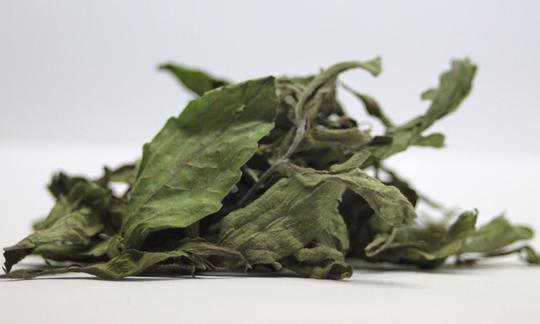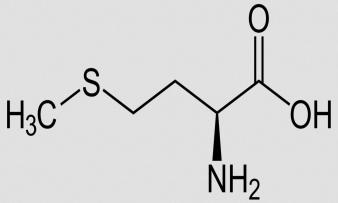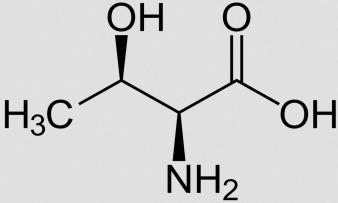Table of contents
Stevia is available in many forms, but the most natural variant is the leaves. Dried stevia leaves (organic) (Stevia rebaudiana) offer enormous sweetness without calories when consumed raw .
Use in the kitchen
Stevia, dried or fresh, is mainly used as a sweetener. The stevioside responsible for this is used as a sweetener on a large scale, particularly in Asia. In Japan, it makes up around 40% of the sugar substitute market. Stevia leaves are around 30 times sweeter than beet sugar, and steviosides are even 150 to 300 times sweeter. One advantage of stevia is its temperature stability, which means it can also be used for baking and cooking. In contrast to sugar, stevia is kind to teeth; it is even suitable as an additive in toothpaste. 4
Unfortunately, the taste is not as neutral as that of household sugar . The leaves are a little bitter. The taste could be compared to liquorice. Stevia should only be used sparingly - the sweetening power is surprisingly strong. To make it easier to use, the stevia leaves can be dried and processed into a powder.
Alternatively, you can prepare an extract of the leaves. To do this, let the leaves steep in hot water for ten minutes. If you put it in a bottle and keep it in the fridge, you have a liquid sweetener ready.
Can you eat stevia raw? You can also use the leaves fresh. To sweeten tea, 1-2 fresh or dried leaves or 1⁄4 tsp powdered leaves per cup. With 10 g stevia leaves you can sweeten about 18 l of tea. 4 Salads, ice cream or other desserts can also be sweetened with raw stevia leaves. To ensure raw food quality, pay attention to the temperature when drying.
Stevia can also be cultivated raw and fresh as a 'kitchen herb' in the garden or as a potted plant on the windowsill.
The sweet herb is particularly useful for people who don't want to give up sweet drinks. Stevia was originally used primarily for this purpose: to sweeten mate tea.
In stevia leaf recipes, the quantities for the ingredient stevia are usually in the form of powder or extracts, so here is a brief description of how to make these ingredients:
Making your own stevia powder and stevia extract
Preparation: Carefully remove the leaves (raw) from the stems. Roughly chop large leaves; this will help them dry faster. Spread the stevia out on a baking tray lined with baking paper. Make sure that the leaves do not overlap. Dry at the lowest oven temperature (usually 40 to 50 degrees) until the leaves are dry enough to crumble with your fingers. It is recommended not to close the oven door completely so that the moisture can escape. Alternatively, you can dry the stevia leaves in a dehydrator on the lowest setting.
A more resource-efficient way to do this is to tie stevia branches into small bunches and hang them up in a warm room to dry. It is best not to do this in a living room or in a room with little dust.
Use a mortar and pestle to grind the dried leaves into a fine powder and place it in an airtight container.
You can then make a stevia extract from the stevia powder:
Preparation: Boil 25 g of stevia leaf powder in 500 ml of water for about one and a half hours until it has reduced to 150 ml. 20 ml of the extract in a glass of water (200 ml) is (on average) the maximum acceptable amount of the extract and contains approximately 250 mg of stevioside. 1
Vegan recipe for lemon iced tea with stevia
Ingredients (2 glasses) : 10 g tea leaves (black tea), 20 ml lemon juice , 500 ml water, 5 ml stevia extract (organic) or about 1⁄2 teaspoon stevia powder, ice cubes, some lemon balm (1 stem with leaves), 1 lemon cut into slices (organic, because you also use the peel)
Preparation: 200 ml Boil water and let the tea steep in it for about 4 minutes. Then strain the tea and mix with 300 ml of cold water. Remember that stevia is many times sweeter than sugar. First add a small amount of stevia extract (a few drops) or stevia powder (about 1⁄8 teaspoon) to the tea. Stir well. Taste the lemonade and gradually add more stevia until you have achieved the desired sweetness. Add lemon juice, lemon slices and lemon balm stalks. Stir and leave to cool in the fridge for two hours. Serve with ice cubes.
Vegan recipes with Stevia can be found under the note: " Recipes that have the most of this ingredient ".
| Not only vegans or vegetarians should read this: Vegans often eat unhealthily. Avoidable nutritional mistakes . |
Purchasing - Storage
The leaves are harvested in September and October , at the latest before the early frost. In temperate climates, the fresh leaves are in season in autumn. If you have a stevia plant in a warm place in the house, you can of course harvest more often. In tropical regions, you can harvest up to five times a year. 4
At major retailers such as Coop , Migros , Denner , Volg , Spar , Aldi , Lidl , Rewe , Edeka , Hofer or Billa , you can mainly only buy stevia in processed form, as steviol glycoside. Even in organic supermarkets, e.g. Denn's Biomarkt or Alnatura , you often only find stevia as an additive in drinks or toothpaste. Stevia plants (fresh and raw) are easiest to buy from organically managed nurseries. Stevia powder made from dried leaves can be found primarily in online shops.
The availability of Stevia varies depending on the size of the store, catchment area, etc. Our recorded food prices for the DA-CH countries can be found above under the ingredient image - and by clicking on them you can see their development at different suppliers.
Storage tips
Dried stevia leaves will last for years if protected from light, moisture and pests.
Ingredients - Nutritional values - Calories
The calorie content of dried stevia leaves is about 146 kcal/100g, which is less than half of household sugar . In addition to the sweet ingredients, stevia leaves contain proteins, carbohydrates, lipids, fiber, oils, vitamins and phenolic compounds. Dried stevia leaves contain (per 100 g dry matter) about 11 g proteins, 77 g carbohydrates, 3.7 g lipids and 16 g fiber. 6
The leaves contain the diterpene stevioside as the main component. This has an extraordinarily high sweetening power, which exceeds that of sucrose by 250-300 times. 4 In addition to stevioside, there are also sweet diterpenes, rebausides and dulcosides (0.7%). Rebaudioside A (4%) has a more neutral taste and a stronger sweetening power than stevioside. There are also diterpenes without sweetening power, e.g. 6-O-acetylaustoinulin, austroinulin, jhanol. Other ingredients are flavonoids (glycosides of apigenin, luteolin, kaempferol, quercetin and quercitrin) and essential oil (nerolidol, caryophyllene oxide, geraniol, spathulenol), 0.1% in the herb and 0.4% in the inflorescences. The leaves contain ascorbic acid , beta-carotene , niacin and trace elements such as iron, silicon, cobalt, manganese, calcium, magnesium, selenium and zinc. 4
The mineral content of dried stevia leaves consists of 21 mg/100g potassium , 18 mg/100g calcium , 15 mg/100g sodium , 3.3 mg/100g magnesium , 0.73 mg/100g copper , 5.9 mg/100g iron and 1.3 mg/100g zinc . 7
Water-soluble vitamins of stevia leaves (dry mass of the extract) are vitamin C (14.98 mg/100g),vitamin B 2 (0.43 mg/100g) and folic acid (52.18 mg/100g). 8
The nutritional values sometimes differ greatly in the various studies. 6 However, since only a very small amount of the stevia leaves is consumed (1-5 g), the nutrients are irrelevant. Of particular interest from a health perspective are the bioactive ingredients and of course the sweetness with hardly any calories (almost zero). We will go into this in more detail in the next section.
Health effects
Are stevia leaves healthy? In studies, researchers have found some positive health effects of stevia:
Due to the drug's diterpenes (especially stevioside), blood pressure is reduced (750-1500 mg stevioside daily). However, the data is inconsistent. 4 Stevioside lowered blood pressure in rats. Stevioside also lowered blood pressure in humans, although in this study the placebo group showed similar results. 6 Dilation of the blood vessels was also observed in connection with stevia. 4, 6
Antimicrobial properties were also found. Methanol extracts appear to be the most effective. Stevia inhibits Staphylococcus aureus and cariogenic bacteria such as Streptococcus mutans and Lactobacillus acidophilus . In the case of urinary tract infections, a synergistic effect was found when used in conjunction with a penicillin antibiotic. 4
Stevia also has an anti-caries effect and inhibits plaque formation. This is why the herb is also used in dental care. It is also said to have a skin-improving effect. 4
Stevia extracts have been shown to have anti-inflammatory and immunomodulatory effects. Due to the high content of phenolic components, as demonstrated in in vitro studies, stevia also has a pronounced antioxidant activity (especially in preparations made from fermented leaves). 4,6
There is evidence of a hypoglycemic effect. Stevia causes an increased release of "human insulin" and a reduction in blood sugar levels (at least in diabetic rats). In vitro, stevia extracts inhibit the activity of alpha-amylase and alpha-glucosidase (= slower breakdown of carbohydrates/reduced blood sugar fluctuations). There was also a suppression of glucagon (the counterpart of "human insulin") and a reduced insulin resistance. 4,6
Stevia also has effects on obesity and metabolic syndrome. Potential effects of stevia and study results in this context: increase in carnitine levels; decrease in tricylglyceride levels in the liver of mice fed a high-fat diet; decrease in body weight gain, food intake, total cholesterol, triglycerides and low-density lipoproteins in rats fed a high-fat diet; improvement in metabolic, oxidative and histopathological indices in a rat model (metabolic syndrome). 11,6
Improvements in some biochemical parameters were also observed in patients with chronic kidney disease. 6
Steviol inhibits the proliferation of human gastrointestinal cancer cells, blocks the early induction of Epstein-Barr virus, and shows high cytotoxicity for cancer cells and lower cytotoxicity for normal cells. Stevioside reduces the viability of colon cancer cells, inhibits DNA synthesis, and induces apoptotic death of cancer cells through mitochondrial apoptosis. 6
Dangers - Intolerances - Side effects
Stevia leaf powder contains approximately 5-10% stevioside. The maximum limit for human consumption is 7938 mg per kg body weight or 476.28 mg per day. 1
Maximum levels are generally prescribed for stevioside. According to EFSA, an ADI (acceptable daily intake) of 4 mg/kg body weight is set for stevia glycosides with more than 95 percent purity. 4
According to the results of a previous study, stevia extract reduced fertility in rats by up to 21% compared to a control group. Fertility remained reduced by 47% even after a recovery period of 50 to 60 days. In rats treated with stevia, a decrease in the relative weight of the seminal vesicle and testes was observed, as well as a significant decrease in the number of stored sperm. 7
Other studies have not been able to confirm this effect. Proof of the safety of stevia is the fact that Paraguayans have been consuming stevia continuously for over 1500 years without any reports of adverse effects. Another confirmation of the safety of stevia consumption is the lack of reports of any kind of side effects in the Japanese population, where stevia is consumed in large quantities. Most studies on the effects of stevia on the human body have not shown any side effects. However, it should be noted that not all stevia products sold are of high quality. 7
According to an expert committee on food additives of the World Food Organisation and the WHO ( JECFA : Joint FAO/WHO Expert Committee on Food Additives ), a maximum amount of stevioside of 2 mg/kg body weight is considered safe. 4
Folk medicine - natural medicine
Traditional areas of application are exhaustion, "heartburn", obesity, hypertension and diabetes mellitus. Stevia is used externally for eczema, psoriasis and wounds, as well as against wrinkles. Stevia is an important part of traditional medicine in Brazil and Paraguay. 4
Ecological footprint - animal welfare
The ecological CO 2 footprint for the production of rebauside A, a steviol glycoside extracted from stevia leaves, is about 20.25 kg CO 2 eq/kg on a mass basis. White cane sugar, on the other hand, has an ecological CO 2 footprint of 0.38-08 kg CO 2 eq/kg. 10 Since stevia has a significantly higher sweetening value, the direct comparison is not meaningful. If one compares stevia on the basis of sweetener equivalents, however, the production of rebauside A with 0.081 kg CO 2 eq/kg only showed about 5.7% to 10.2% of the greenhouse potential of cane sugar production. The researchers of the underlying study concluded that rebauside is a more resource-efficient sweetener. 9 In the In the study on which Rebauside A is based, it was produced on a small scale, with farmers cultivating an average of 0.83 hectares of land alone. Larger cultivation of stevia could lead to greater efficiency and environmental compatibility than this study shows. 9
In order to keep the ecological footprint as small as possible, you can also grow stevia yourself. This eliminates unnecessary transport and packaging.
Stevia is impressive because of its sweetening power, without the negative effects on the body that usually come with it. Many large corporations are now taking advantage of this - in 2015 alone, the stevia industry was estimated to be worth 492 million dollars per year. However, it is not the people on whose knowledge the use of the plant is based - the Guarani in Paraguay - who are profiting from this industry, but rather large companies such as Coca Cola or Pepsi. It is even referred to as a form of biopiracy, where outsiders or companies use and exploit indigenous knowledge. 12
Worldwide occurrence - cultivation
In its original distribution area, stevia has been used for centuries due to its sweetness. The Guarani Indians use stevia (kaà heè) to sweeten mate tea. Stevia is native to the border region between Paraguay and Brazil. The herb is grown in many countries in South America and Asia. Although the plant is perennial, it is usually cultivated as an annual, mainly because it does not tolerate frost. 4
Stevia came to Europe via Spanish conquistadors in the 17th century. In 1888 , Dr. Moiseés Santiago Bertoni examined the plant scientifically for the first time. 4
Cultivation - Harvest
The plant prefers sandy, loamy, humus-rich soils of volcanic origin. It reaches an average height of 40 cm and has a strong rootstock with shallow, strikingly cylindrical roots. The lower parts of the stem are lightly downy and woody. The oppositely arranged, 2-4 cm large leaves are lanceolate or spatulate and lightly glandular. Their edges are serrated in the upper part and entire in the lower part. The small white flowers, which have purple bracts, are arranged in umbels. 4
You can harvest about 15-35 g of leaves from one plant. Under optimal temperature conditions, it grows for about six years and is harvested about 5 times a year. 4
Industrial production
The diterpene stevioside is used in particular as a sweetener for drinks and other foods. Stevioside is obtained in crystalline form by extracting the leaves with water and then concentrating and purifying them. It has been approved as a food additive in the EU since the end of 2011. 4
Further information
The perennial subshrub found in America belongs to the daisy family (Asteraceae). The genus name Stevia , in Latinized form (stevius), refers to Pedro James Esteve , a doctor and botanist of the 16th century. The species name reubaudiana refers to the Paraguayan chemist Ovid Rebaudi , who isolated two active ingredients of the plant, one sweet and one bitter, in 1900. 4
The genus includes about 230 species. Its distribution area extends from the southern states of the USA to Argentina. 4
Alternative names
In English, the herb is called 'candyleaf', 'sweetleaf', 'sugarleaf' or 'stevia'. German alternative names are sweet herb or honey herb. The drug name is 'Stevia rebaudianae folium'.
Other applications
The food additive steviol glycoside (E 960) is obtained from the stevia leaves. 5








Comments